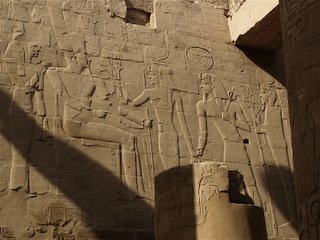 Karnak: Temple of Amun was built in ancient Thebes, now known as Luxor.
Karnak: Temple of Amun was built in ancient Thebes, now known as Luxor. The entrance has two rows of sphinxes which lead to the Nile river. At another part of the temple there is another row of sphinxes that were on either side of the street from the Karnak Temple to the Temple of Luxor.

Check out the Luxor Temple photos to see the row of sphinxes there. There were processions that would go from one temple to the other.
When you first enter you see a large column and yet another Colossus of Ramses II. If you look closely there is a smaller statue at the feet and knees of Ramses II, it is one of his daughters, unfortunately I do not have her name.

Once you pass this section you reach the Great Hypostyle Hall, which is truly magnificent with all of those large columns. It is this temple that has the great columns that you see in photos and in movies (yes that's Wendy in there) and as Wendy and I found out, when one speaks you can NOT figure out where in the hall they are, sounds bounce off that much! There are 134 columns, in all, in the Great Hypostyle Hall, each one with high relief carvings of gods, cartouches, and stories of the gods. The center 12 columns are a little under 69 feet high and the other 122 columns are 49 feet tall. It took many pharoahs to complete this temple, starting in the 11th dynasty (2055 - 1985 BC) by Montuhotep II-IV and culminating in its grandest expansion during Ramses II reign in 1279-1213 BC.


The other photos are some of the reliefs depicting offerings to their pharoahs or their gods and then some hieroglyphs.
One interesting story, and proof that all of our rituals and symbols in today's religions stem from historical events, that has come out of learning about Egyptian history is there was an event called the Festival of Opet at Karnak. Even though Karnak Temple was principally for the god Amun, the god of Thebes, the temple also worshiped Mut (his wife) and their son Khonsu. Once a year during the flood season of the Nile, the Festival of Opet celebrated the king's rebirth as the son of Amun (whomever the pharoah was at the time). Priests (actually those working for the priests) would carry images of the three gods (Amun, Mut and Khonsu) onto boats called barques (decorated) and they would sail to Luxor Temple. Parts of the Opet Festival are still used today during the Islamic Moulid of Abu al-Haggag, a five-day festival preceding Ramaden. Interesting, isn't it.

No comments:
Post a Comment